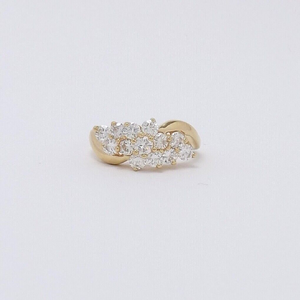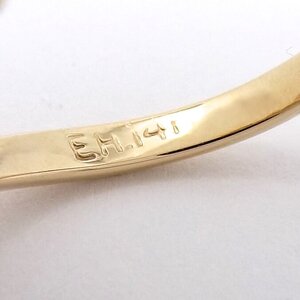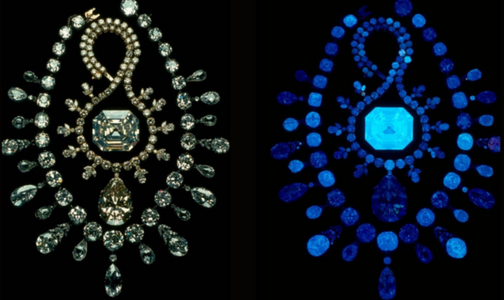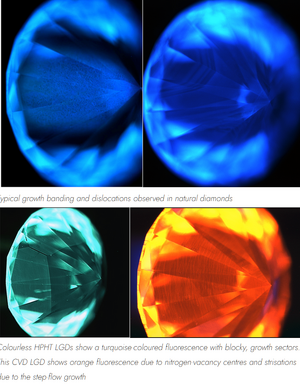GemView
Shiny_Rock
- Joined
- Jul 25, 2005
- Messages
- 243
So I don't often buy preowned jewelry but occasionally a piece catches my eye and I bite the bullet. I bought a ring recently from an eBay seller with 100 percent feedback, someone I have purchased from in the past. The ring consists of a vintage waterfall cluster with 3/4 carat of diamonds (shown in attached photo). The diamonds were said to be F-H/VS clarity by the seller's in-house gemologist (seller owns a retail jewelry shop). Upon receipt the diamonds were blindingly bright, with tons of fire — so much so that I wondered if they were moissanite or potentially lab diamond.
I decided to have the prongs/stones checked the other day and in the course of this was told that the diamonds are lab grown. I then took the ring to two other jewelers and was told the same thing — but none of them had a diamond tester that can tell the difference. (They based this on the lack of inclusions.) I contacted the seller and asked how they verify preowned pieces and was told "We have a CVD HTHP tester. It is top of the line. 99% accurate".
I have to admit these diamonds have a "too good to be true" appearance. The diamonds in this ring even out-perform the Costco diamond jewelry I own. (The attached photos don't even begin to capture the amount of fire this ring puts out under any kind of light.)
It occurred to me to drop in to PS and ask whether the introduction of lab diamond jewelry into the market has made anyone think twice about going on a preowned "treasure hunt"?
Given that many sellers of estate jewelry, pawn shops and the like, can't attach an appropriate resale value to these pieces if they lack in-house method to reliably differentiate lab from earth-mined, the best strategy may be to assume everything is lab grown and to pay accordingly. However, this may also be unrealistic given that many resellers no doubt default to the assumption that diamonds are mostly earth mined, given that lab diamonds are relatively new on the market.
In this case, I paid a price that would be fair for earth mined — but overpriced if the diamonds are lab-grown. I have only two more days to determine if I should request a return. I can only guess that based on the styling — the popularity of the waterfall style as best I can recall peaked in the 1990s — it is unlikely to be suggestive of lab diamonds. To that end, it occurred to me that the maker's mark inside the band might offer up some clues but I can't seem to track down the identity of EH (see attached photo).
Decisions! Decisions!
I'd love to hear your thoughts.
Edit: To clarify, I own a mix of lab and earth-mined diamond jewelry. It's just for purposes of valuation I am now struggling to understand how I shop preowned diamond jewelry In the future, since the resale value on jewelry is not all that great to begin with and presumably even less so for lab created.

I decided to have the prongs/stones checked the other day and in the course of this was told that the diamonds are lab grown. I then took the ring to two other jewelers and was told the same thing — but none of them had a diamond tester that can tell the difference. (They based this on the lack of inclusions.) I contacted the seller and asked how they verify preowned pieces and was told "We have a CVD HTHP tester. It is top of the line. 99% accurate".
I have to admit these diamonds have a "too good to be true" appearance. The diamonds in this ring even out-perform the Costco diamond jewelry I own. (The attached photos don't even begin to capture the amount of fire this ring puts out under any kind of light.)
It occurred to me to drop in to PS and ask whether the introduction of lab diamond jewelry into the market has made anyone think twice about going on a preowned "treasure hunt"?
Given that many sellers of estate jewelry, pawn shops and the like, can't attach an appropriate resale value to these pieces if they lack in-house method to reliably differentiate lab from earth-mined, the best strategy may be to assume everything is lab grown and to pay accordingly. However, this may also be unrealistic given that many resellers no doubt default to the assumption that diamonds are mostly earth mined, given that lab diamonds are relatively new on the market.
In this case, I paid a price that would be fair for earth mined — but overpriced if the diamonds are lab-grown. I have only two more days to determine if I should request a return. I can only guess that based on the styling — the popularity of the waterfall style as best I can recall peaked in the 1990s — it is unlikely to be suggestive of lab diamonds. To that end, it occurred to me that the maker's mark inside the band might offer up some clues but I can't seem to track down the identity of EH (see attached photo).
Decisions! Decisions!
I'd love to hear your thoughts.
Edit: To clarify, I own a mix of lab and earth-mined diamond jewelry. It's just for purposes of valuation I am now struggling to understand how I shop preowned diamond jewelry In the future, since the resale value on jewelry is not all that great to begin with and presumably even less so for lab created.

Attachments
Last edited:







300x240.png)